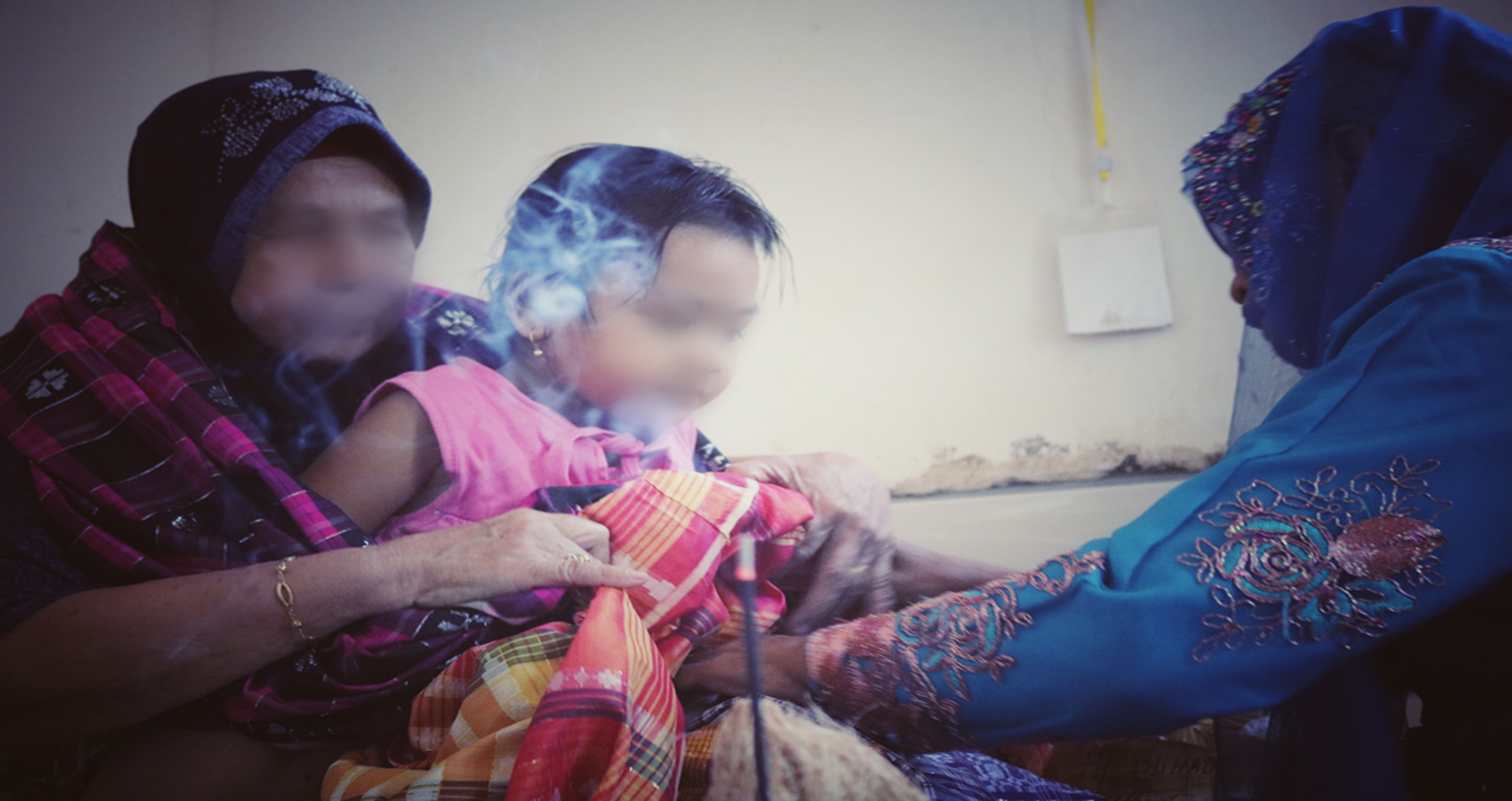Female Genital Mutilation

Little Buginese girl in Makassar, Sulawesi, Indonesia undergoing traditional genital mutilation procedure.
Photographer: Herwin Bahar (Shutterstock, 2020). Comment: Humanexus has blurred the pictured faces.
Female Genital Cutting and the Ethnocentric debate
Insert graph
If we take a numerical approach, there has been an overall decline in FGC practices thanks to leading NGOs on the practice, such as the United Nations (UN), the WHO, and the Pan African Parliament (PAP). Worldwide, the percentage of girls aged between 15 and 19 who have undergone FGC was 51% in 1985, 46% in 2010 and 37% in 2016 (UNICEF, 2016). Albeit it is important to recognize this decrease, individual countries have not all seen a decline. In Yemen, 85% of girls will undergo FGC in the first week after their birth (UNICEF, 2016). This is not a secluded issue with an estimated 137,000 women and girls living in the UK who have experienced FGC (Recchia & McGarry, 2017). In countries where FGC is practice, it is a symbol of pride and social acceptance. FGM is considered an essential part of raising a girl that prepares her for adulthood and marriage. The purpose is to ensure premarital virginity and marital fidelity (WHO, 2020). Yet this perception changes once a woman migrates to a Western country, where FGC is not practiced nor authorized. As the woman starts question the practice, common reactions are anger and shame for being different. This feeling of low self-worth is also perpetuated by the look of disgust on health care professionals (Recchia & McGarry, 2017).
Percentage distribution of ages at which girls have undergone FGM (as reported by their mothers). United Nations Children’s Fund, Female Genital Mutilation/Cutting: A statistical overview and exploration of the dynamics of change, UNICEF, New York, 2013:
Insert graph
The health consequences include obstetric, neonatal, urologic, gynecologic, infectious, and sexual complications (Payne et al, 2019). The major consequences on mental health include depression, anxiety, and Post-Traumatic Stress Disorder (PTSD) (Recchia & McGarry, 2017). Women who have suffered from FGC are 52% more likely to experience dyspareunia (painful sexual intercourse as a result of medical or psychological causes) (Payne et al, 2019). In Eastern Sudan, only 7% of midwives were able to identify the different types of FGC yet 81% of them had, actually, practiced the procedure (Payne et al, 2019). Indeed, there are four different types of FGC that all fall under the same terminology (WHO, 2020). Type 1 includes partial or total removal of the clitoral glans; type 2 involves the abstraction of the clitoral glans and the labia minora (the inner folds of the vulva). Type 3 is the narrowing of the vaginal opening and type 4 incorporates other procedures such as pricking, piercing, incising or scraping of the genital area (WHO, 2020). The drawback of having one term that encapsulate all is that the actual implications and health dangers of each specific one isn’t taken into consideration. It creates an endangering impression that FGM is a monolithic practice (Earp & Johnsdotter, 2020). Albeit the main argument surrounds physical and mental health, an economic argument can also be made. In short, there is an estimated 1.4 billion USD for the treatments of health complications across the 27 countries with the highest prevalence. This is expected to increase by 68% in the next 30 years if no measures are not taken. Yet, if the practice is abandoned drastically, the cost decrease would be 60% over 30 years (WHO, 2020).
The Pan African Parliament (PAP) has recently joined the United Nations to ban the practice on the whole continent. To do so, the actions planned are: legislation changes, community mobilization, advocacy, and the urge for men to speak out against it (Payne et al, 2019). If we look at countries where measures have increased, a drastic diminution is seen. Prevalence in Kenya decreased from 41% in 1984 to 11% in 2014. Indeed, the government made the practice illegal in 2011 with the Children’s Act, the Prohibition of female Genital Mutilation Act as well as using social pressures such as men saying they would rather marry someone who didn’t have FGC (Payne et al, 2019). In 1996, Burkina Faso altered its legislations making FGC illegal with imprisonment between 6 months and 3 year for practitioners. Police Officers were trained, and women were educated on the health consequences to ensure that mothers would not want the practice done on their child. Women who had undergone FGC would be able to access free sexual health care. The prevalence rate declined from 89% in 1980 to 58% in 2010 (Payne et al, 2019).
However, despite the clear physical and psychological consequences and the good intentions of the World Health Organization (WHO), its involvement can also be seen as a Western dogma. Earp and Johnsdotter, in their 2020 research, have showcased how a dominant ideology around FGC can negatively affect populations and their individuals. They argue that the definition fails to include a definition of medical reasons, nor does it take into consideration consent, the severity or their consequences. The discourse around FGC has shifted drastically in the last seven years. Before, the conversation was mainly around the (sexual) health risks associated and ensuring that women are free from gender-based violence. However, recently, the conversation has turned to the male dominance over female sexuality. In the Western world, some forms of FGM are tolerated, for example in the case of transgender men and women, “cosmetic” genital procedure, or differences of sex development. Indeed, there is an emerging critical consensus around the FGC in developing countries and how these are often “misleading, oversimplified and false empirical assumptions” or in other words top-down approaches. There is a failure to appreciate the cultural reasoning behind the practice in third world countries with the same importance that it is considered in the Western world. Cultural bias is extremely common in humanitarian work and yet is such an important component (Earp & Johnsdotter, 2020).
Humanitarian aid is undoubtedly beneficial, yet only if it is appropriate for the targeted group. In the case of FGC, there is clear evidence that health issues are prominent thus making it important to tackle but, as we have seen, culture needs to be prioritized or methods will seem hypocritical. As debated previously by Earp and Johnsdotter, there are arguments around WHO only targeting non-Western types of FGM, with debates around gender bias and cultural imperialism. Although the need for humanitarian support is crucial when it involves mutilation, a more specialized approach would be deemed more appropriate.

Sarah Marine Surget

Categories
Categories, Equality, Health, Highlighted, Human rights, Statistics


